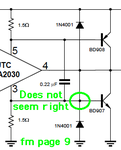jovin555
Advanced Member level 4
I am trying to build the active cross over circuit of TDA2030 given in Page 9 in the attached pdf.When i power up the circuit with 12V input power supply,The pnp transistor BD908 is getting heated up.(I am using TIP42C instead of BD908).Can anyone let me know why this is happening.I have connected a 4ohm output resistive load for testing purpose.I am also using a heat sink for all the TDA2030 and transistors.
Attachments
Last edited:

